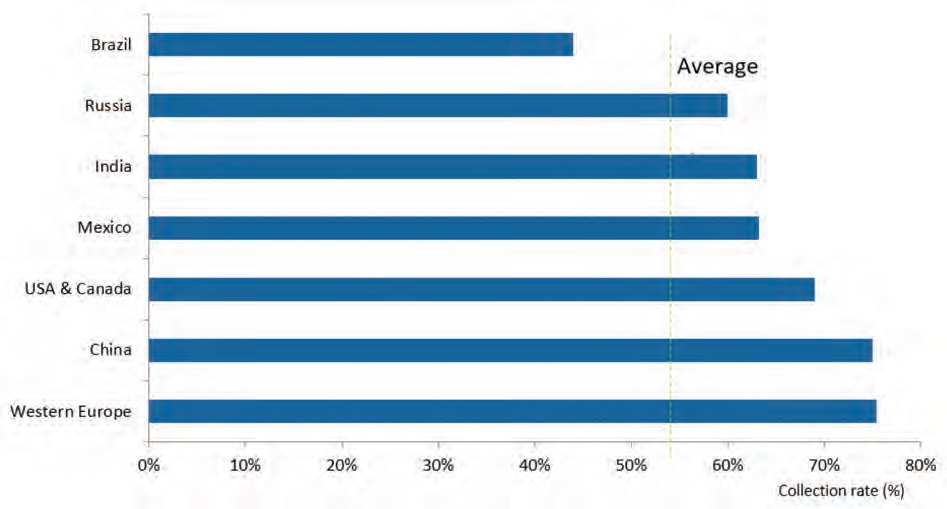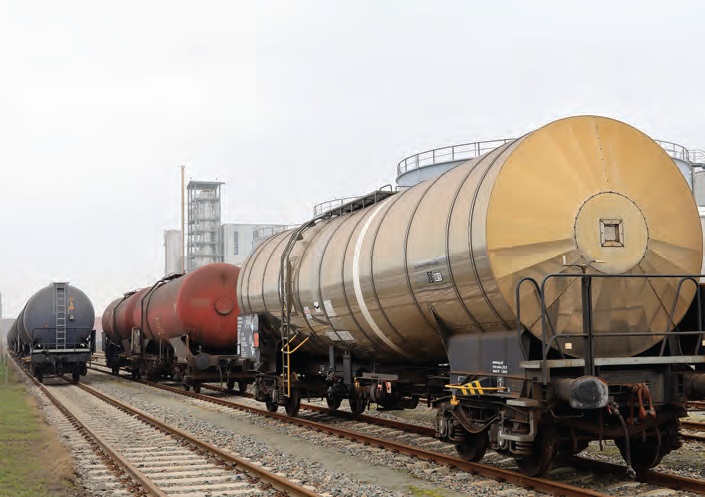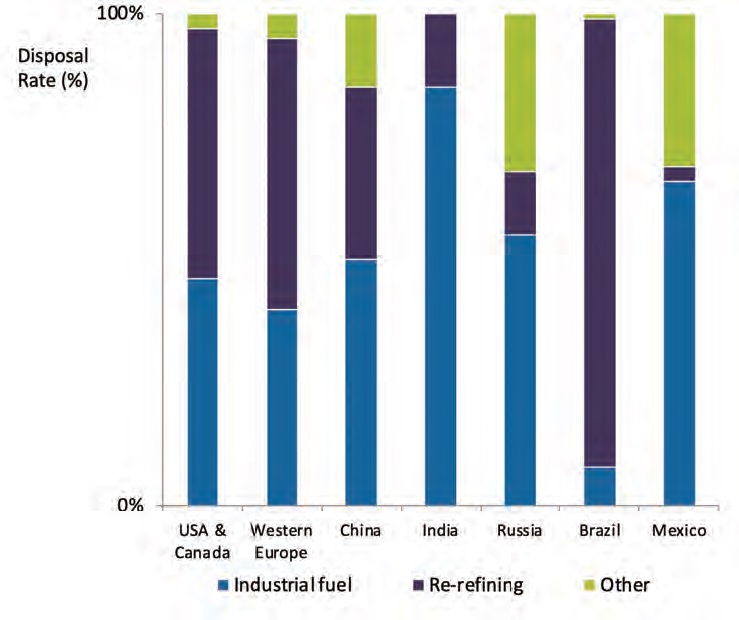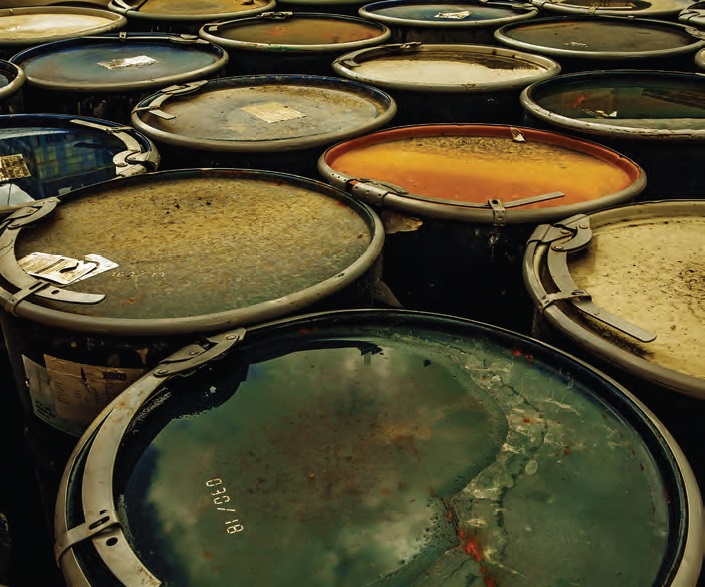 Kline’s recently published
Kline’s recently published study “Global Used Oil and Re-Refined Lubricants Market” identified the growing gap between the re-refining industries in developed and developing countries. The re-refining industry is evolving in two different directions. In the developed countries of Western Europe and the U.S., as well as in Brazil, the industry already has significant Group II re-refined base stock capacity, and more is being added or upgraded to produce higher quality base stocks. On the other hand, in the developing markets of Russia, India and Mexico, re-refiners struggle to procure enough used oil due to other avenues that are available for its disposal, for example, illegal dumping or its use as fuel. China stands somewhere in between the developing and developed markets.
What is used oil?
Finished lubricants are unique among refinery products, as they are not entirely consumed during their use. At the end of their service life, the lubricants that are drained are referred to as “used oil.” The amount of used oil generated and the type of contaminants that it contains are dependent on the lubricant type and service conditions. Origin, use, and contaminants are among three main criteria that determine if a substance is a used oil or not.
The difference in used oil collection and generation
The used oil generation and collection volumes are not the same, and there will be some
in situ losses. Nonetheless, the concept of used oil-generated volume is important, since improvements in collection volumes will bring growth—even if the finished lubricant market is flat or declining. The difference between used oil generated and used oil collected indicates the potential growth avenue for the industry. There are differences between the used oil generated in different markets. Generally, the used oil generated is in the range of 50%-60% of total lubricant demand in a market. Developed markets, such as North America and Western Europe, are closer to the upper end of this range, while markets such as China and Brazil are closer to the lower end of the range. This is mainly due to differences in the relative share of different types of lubricants in the overall lubricant market (
see Figure 1).
 Figure 1. Used oil collection rates by region, 2019
Figure 1. Used oil collection rates by region, 2019
Note: Collection rate is a ratio of used oil collected to used oil generated in terms of percentage.
Factors influencing used oil usage
There are four factors that govern the usage of used oil as fuel: (1.) re-refining capacity, (2.) demand for re-refined base stocks, (3.) quality of used oil and (4.) enforcement of regulations. Developed countries are grappling with issues of low re-refining capacity or low demand for re-refined base stocks due to an abundant supply of virgin base stocks. However, the demand for re-refined lubricants is growing in the developed markets, especially the U.S. Some re-refiners in the developed markets, such as the U.S., are selling re-refined lubricants under their own brand. However, they are not marketing these lubricants aggressively. This is because a large portion of their re-refined base stocks production is already tied up in contracts with customers. So, these re-refiners do not want the demand for branded re-refined lubricants outstrips supply, as that would create a negative perception of their products in the market. This also adversely impacts the growth of re-refined lubricants demand in developed markets. The developing countries, however, are working to solve challenges such as the quality of used oil and poor enforcement of regulations. This is leading to no, or very slow, development of the re-refining industry in developing countries.
Diverging disposal routes
The eight markets studied—U.S., Canada, Mexico, China, Western Europe, Brazil, Russia and India—account for 65% of global lubricant demand and together generate nearly 15 million tonnes of used oil. However, the disposal routes of this used oil differ sharply between the developed and developing countries.
 Finished lubricants are unique among refinery products.
Finished lubricants are unique among refinery products.
Strongly enforced regulations, combined with an established collection system in Western Europe, Brazil, China, the U.S. and Canada, mean they have the highest collection and disposal of used oil. In most of the developed countries, more than 50% of used oil is supplied for re-refining. Developing countries also have good collection rates, since people understand that the used oil has an economic value. But the share of re-refining is less than 20% due to lax enforcement of regulations, which means most of the used oil collected is disposed of as fuel (
see Figure 2).
 Figure 2. Used oil disposal routes vary significantly by different markets.
Figure 2. Used oil disposal routes vary significantly by different markets.
 Contamination is one criteria that determines if a substance is a used oil.
What lies ahead?
Contamination is one criteria that determines if a substance is a used oil.
What lies ahead?
Looking toward 2028, re-refining rates are expected to grow. This will be driven by a number of factors, including increased re-refining capacity, growth in demand for re-refined products, the increased availability of higher quality used oil, and stronger enforcement of regulations. The ability to produce re-refined Group II and III base stocks to meet the growing demand for higher quality finished lubricants in the automotive sector will enable re-refiners to compete more effectively with virgin base stock producers. However, the base stock market is constantly changing. From a time when base stock prices were high—creating an incentive to maximize used oil collection—it has come full circle to a time of low crude oil price, resulting in low prices of virgin base stocks. In this challenging market, it is essential for used oil collectors, re-refiners, lubricant blenders and marketers to be agile so that they can shift operations to capitalize on the opportunities that do arise. To gain the latest insights about used oil and the re-refined lubricants market, request the recording of our recent webinar presentation.
1
REFERENCE
1. Mahajan, K. (2020), “From Finished Lubricants to Used Oil,” Kline Group,
https://www2.klinegroup.com/used_oils_market_2020.
Kunal Mahajan is project manager—chemistry and energy practices at Kline & Co. You can reach him at kunal.mahajan@klinegroup.com .
Kline is an international provider of world-class consulting services and high-quality market intelligence for industries that include lubricants and chemicals. Learn more at www.klinegroup.com.